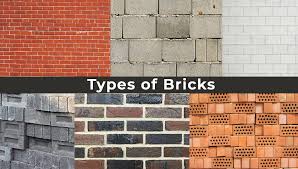Bricks are a fundamental building material used in construction due to their durability, strength, and aesthetic appeal. Here’s a detailed overview of various types of bricks and their specific uses:
1. Clay Bricks
-
Fired Clay Bricks: Made from clay that is molded and then fired in a kiln. They are strong, durable, and resistant to weather and moisture.
- Uses: Commonly used for walls, facades, and paving.
-
Soft Mud Bricks: Made by pressing wet clay into molds, often left unburned or air-dried.
- Uses: Primarily for low-cost housing and temporary structures.
-
Extruded Bricks: Produced by forcing a mixture of clay through a die to create a long column that is cut into bricks.
- Uses: Used in industrial buildings and for structural walls due to their uniformity.
2. Concrete Bricks
-
Hollow Concrete Blocks: Made from a mixture of cement, aggregates, and water. They often have hollow cores that reduce weight and improve insulation.
- Uses: Commonly used in load-bearing walls and foundations.
-
Solid Concrete Bricks: Denser and heavier than hollow blocks, made entirely of concrete.
- Uses: Ideal for walls that require additional strength and durability.
3. Fly Ash Bricks
- Made from fly ash, a byproduct of coal combustion, mixed with water and lime, and then cured.
- Uses: Lightweight, eco-friendly, and used in non-load-bearing walls, infill panels, and partition walls.
4. Sand Lime Bricks (Calcium Silicate Bricks)
- Made from a mixture of sand, lime, and water, then cured under high pressure.
- Uses: Known for their strength and durability, they are often used in load-bearing walls and as a fire-resistant option.
5. Refractory Bricks
- Made to withstand high temperatures, often used in kilns, fireplaces, and furnaces.
- Uses: Ideal for industrial applications where heat resistance is critical.
| "BEST BUILDER FLOOR APARTMENT IN CHENNAI" |
6. Stone Bricks
- Natural stones cut into brick shapes, offering a rustic and aesthetic appeal.
- Uses: Used in decorative facades, pathways, and landscaping.
7. Glazed Bricks
- Clay bricks coated with a glass-like glaze, providing a decorative and weather-resistant surface.
- Uses: Often used in exterior walls, bathrooms, and kitchens for their aesthetic and easy-clean properties.
8. Engineering Bricks
- High-strength bricks with low water absorption, often made from dense clay or concrete.
- Uses: Suitable for structures requiring high compressive strength and resistance to moisture, like foundations and damp-proof courses.
9. Fire Bricks
- A subtype of refractory bricks designed specifically for high-temperature applications.
- Uses: Used in fireplaces, pizza ovens, and other high-heat environments.
10. Perforated Bricks
- Clay bricks with holes (perforations) that reduce weight and improve thermal insulation.
- Uses: Used in non-load-bearing walls and for sound insulation.
Conclusion
Each type of brick serves specific purposes based on its material properties, making them suitable for various construction needs. When selecting bricks for a project, consider factors like strength, thermal insulation, moisture resistance, and aesthetic requirements. This will ensure that the structure is both durable and visually appealing.
Also read: Construction Techniques
https://www.livehomes.in/blogs













